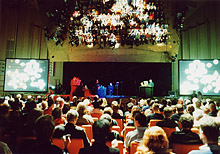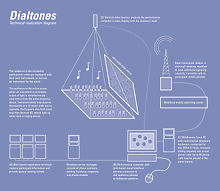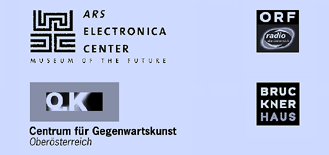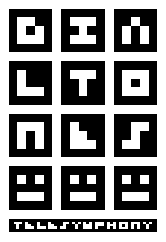| DIALTONES (A TELESYMPHONY) A concert performed entirely through the ringing of the audience's mobile phones. [Deutsche abstract] Presented Sunday, 2 September 2001 at the Brucknerhaus Auditorium in Linz, Austria as a production of TAKEOVER: the 2001 Ars Electronica Festival, and 28 May - 6 June 2002 at the Arteplage Mobile de Jura as a production of the Swiss National Exposition and Swisscom Mobile. |
||||
|
||||
|
CONTRIBUTORS
|
||||
| OVERVIEW Dialtones is a large-scale concert performance whose sounds are wholly produced through the carefully choreographed dialing and ringing of the audience's own mobile phones. Because the exact location and tone of each participant's mobile phone can be known in advance, Dialtones affords a diverse range of unprecedented sonic phenomena and musically interesting structures. Moreover, by directing our attention to the unexplored musical potential of a ubiquitous modern appliance, Dialtones inverts our understandings of private sound, public space, electromagnetic etiquette, and the fabric of the communications network which connects us. Dialtones was presented in two consecutive concerts in September, 2001, as a co-production of Golan Levin and the Ars Electronica Festival, and in seventeen performances in May/June 2002 at the Swiss National Exposition. Dialtones begins with a brief preparation phase prior to its performance, during which the members of the audience register their wireless telephone numbers at a cluster of secure Web kiosks. In exchange for this information, the participants receive seating assignment tickets for the concert venue, and new "ringtones" are then automatically downloaded to their handsets. During the concert itself, the audience's mobile phones are brought to life by a small group of musicians, who perform the phones en masse by dialing them up with a specially designed, visual-musical software instrument. Because the audience's positions and sounds are known to the Dialtones computer system, the performers can create spatially-distributed melodies and chords, as well as novel textural phenomena like waves of polyphony which cascade across the crowd; these musical structures, moreover, are visualized by a large projection system connected to the performers' interfaces. Towards the end of its half-hour composition, Dialtones builds to a remarkable crescendo in which nearly two hundred mobile phones peal simultaneously. It is hoped that the experience of Dialtones can permanently alter the way in which its participants think about the cellular space we inhabit. |
||||
| ARTISTS'
STATEMENT Wireless telephony has quickly become an indispensable aspect of modern life. Today, one out of ten people on the planet possesses a mobile phone; over the next three years, according to the industrial analysis firm The Gartner Group, this market is expected to increase by almost a billion new users [1]. Ironically, the astonishing eagerness with which we have adopted mobile phones is matched by our almost equal repulsion on the occasion of a cell phone's ringing. Mobile phones now infuse our theaters and public spaces with the least welcome details of our neighbors' intimacies, and perforate our private lives with the sonic machinery of electronic commerce. Our emotional reactions to these interjections can even outstrip the veneer of our professional identities: when ringing mobile phones interrupted keynote speakers at a recent telecommunications conference in Finland, the conference manager became enraged and threatened to get a radio-frequency scrambler to silence the din [2]. Caught between adoration and irritation, we have come to regard our intimate communications apparel with a deep ambivalence. In the hype, hate and hypnosis surrounding the mobile phone, its potential as an ingredient of art has been largely overlooked. As with the proverbial fish who would never discover water, we take for granted that we are immersed in cellular space, our imaginations dulled by the extraordinary ubiquity of our wireless devices. Announcers at every modern-day concert command us to turn off our cell phones, but what Cagean aesthetic possibilities might we discover in leaving them on? What deranged beauty might we find, or what might we learn about our interconnected selves, in their high, pure tones? The mobile phone's speakers and ringers make it a performance instrument. The buttons make it a keyboard and remote control. Its programmable rings make it a portable synthesizer. Yet, although no sacred space has remained unsullied by the interruptions of mobile phone ringtones, there is no sacred space, either, which has been specifically devoted to their free expression. In the context of this lack, and in the context of our society's contradictory attitudes towards wireless communication technologies, Dialtones is proposed. If our global communications network can be thought of as a single communal organism, then the goal of Dialtones is to indelibly transform the way we hear and understand the twittering of this monumental, multicellular being. One of Dialtones's strategies for doing so is the musical reification of this organism's sprawling and enveloping omnipresence. By placing every participant at the center of a massive cluster of distributed speakers, Dialtones makes the ether of cellular space viscerally perceptible. In a rejoinder to the eminent electronic composer Iannis Xennakis— who once complained that all electronic music sounded alike, because it would inevitably emanate from the same pair of speakers —Dialtones's radical surround-sound is at once musically and phenomenologically unique. In an appropriate acoustic environment, the sporadic triggering of calls to mobile phones can evoke the placid chirps and trills of crickets, cicadas, frogs and birds. If hundreds or even thousands of mobile phones were to ring simultaneously, by contrast, the result would be an unimaginably seething, engulfing cacophony. Between these two textural extremes lies an enormous terrain of more musically familiar possibilities: gently shifting diatonic chord progressions, distributed and aggregate melodies, roving clouds of spatialized sound-clusters, and pointillistic hyper-polyphonies. Over the course of its half-hour duration, Dialtones explores sequences and combinations of each of these possibilities, scaffolded throughout by a set of recurring harmonic themes and slowly-evolving melodic phrases. Ultimately, the exact composition of Dialtones is a function of both the scored performance produced by the project's staff, and the specific settings of the phones brought by the concert's attendees. In Dialtones, the phones, and not their owners, speak to one another. By summoning a communication between communications technologies in which there is no interlocutor, Dialtones invites its participants to perceive an order in what is otherwise disorganized public noise, and ratify it as a chorus of organized social sound. Thus the overdetermination of the world of Work is countered with an equally determined Play, as the ringing of mobile phones—ordinarily, the noise of business, of untimely interruptions, of humans enslaved to technology—is transformed into a sound of deliberate expression, startling whimsy, and unconventional beauty. |
||||
| TECHNICAL
REALIZATION Dialtones' technical realization is broadly divided into three distinct software subsystems: (A) the means by which the audience's mobile phones were registered (prior to the performance) into a networked database; (B) the means by which the audience's cell phones were computationally dialed (and thereby performed) during the concert itself; and (C) the telephony middleware which communicated the dialing requests from the performance system to the infrastructure of the local Mobile Switching Center. In addition, two special optical subsystems added visual and diagrammatic dimensions to the performance: (D) a vertical video projection system, in which spots of light were cast from above onto actively ringing audience members; and (E) an assembly of autonomous miniature lights which visually augmented the audience's highly-localized cellular activities. In this section, each of these mechanisms is treated in turn. A. Prior to the Dialtones concert, audience participants register their mobile phone numbers (and model numbers) at special Web-based terminals placed outside and around the performance venue. ASP-based CGI scripts are used to store this information in a SQL database. At the same time, the scripts also use a ticketing algorithm to issue the audience member an assigned seat in the concert auditorium. Depending on the make and model of the participant's phone, it can be possible to programmatically modify its ringtone at this time; if so, a specially-composed ringtone is encoded in the RTTTL (ringtone text transmission language) data format and transmitted to the user's phone as an SMS message. The Dialtones staff composed more than 100 customized ringtones for the concert, wrote special software to convert these ringtones from MIDI sequences into RTTTL, and created a special CGI system to transmit these tones automatically to the audience's phones. In the Linz performances, a small number of preconfigured phones were also available as temporary loans for phoneless participants. B. After the participants' phone numbers and models have been collected and stored in a database, Dialtones itself is performed live on a custom software instrument which makes use of this database. This performance system consists of an interactive graphical software interface, which represents each mobile phone in the audience as a spatialized cell in a visual grid. During the performance, the performers place "animated paint" into specific cells in the visual grid; these actions trigger the ringing of the corresponding mobile phones in the audience. It is important to emphasise that all of the phone dialings are executed "by hand"; that is, they are set into motion by the direct action of a human performer. The performance instrument is implemented as an OpenGL-based Windows application. C. The Windows-based performance software transmits dialing requests over a TCP/IP LAN to a nearby Linux-based telephony server. This machine uses an Aculab telephony card to convert these requests into actual phone calls. The Aculab card transmits the phone calls over two dedicated E1 lines (primary-rate 2Mbit ISDN connections), directly into the Mobile Switching Center (MSC) of the local mobile service provider (in Linz, A1 Mobilkom Austria; at the Swiss National Exposition, Swisscom Mobile). The local Base Transceiver Station (BTS, or cell antenna) in the location of the concert venue was specially modified by the provider in order to allow at least 60 simultaneous signalling channels. D. The audience-orchestras at the two Linz performances each consisted of 200 participants, who were arranged in a 20x10 seating grid. The performers' grid-based graphical interface is projected onto the audience from above, and carefully registered with their seats. As a result, each participant is lit up by a personal spot of light whenever their handset is rung. The concerts performed in Linz used a 12000 ANSI Lumen Barco ELM R12, with a special wide-angle lens, for the projection of these spotlights. In order to more clearly show how the spots of light play across the audience— indicating which people are ringing at any instant— a very large, multi-panel Mylar mirror (6x12 meters) is erected at an angle above the crowd. Of the 200 participants in Linz—whose phones hailed from 13 different countries—as many as sixty could be dialed at any one instant. Each performance lasted approximately 28-30 minutes, and entailed the placement of more than 5000 phone calls. The seventeen concerts presented at the Swiss National Exposition used orchestras of 99 participants [9x11], of whom any 60 could be dialed simultaneously. E. The last visual subsystem consisted of a set of two hundred small keychain lights, which were distributed to the audience-participants at the time of their pre-concert registration. These inexpensive and autonomous devices, which are sensitive to energy in the 800-1900 mHz radio band, illuminate a small red LED when they are within one meter of a ringing mobile phone. Despite their small size, the darkness of the concert hall made it possible to observe the flashing of these lights, which were also reflected in the large suspended mirror. Generally speaking, these keychain lights would flash about two seconds prior to the ringing of a nearby mobile phone, while the overhead video projection system would typically enable its corresponding spotlight within half a second after the phone had begun to ring. These minute differences in timing had the effect of diffusing events over time, creating micro-anticipations and multilayered syncopations between the light and sound of the performance. The combined effect of the telephone rings with their synchronized visual phenomena was to render each participant as an audio-visual pixel, a twinkling particle in an audio-visual substance—and the visitors, as a group, could at once be audience, orchestra and (active) score. [Graphical interface screenshot] [Technical diagram PDF] [Performance Score PDF] |
||||
| THE
COMPOSITION The Dialtones composition consists of three major subsections, or "movements", each approximately ten minutes long. The first section is produced entirely through the ringing of the mobile phones of the 200-person audience; these phones were completely unamplified by any means. The second section, a "solo" movement, is performed by Dialtones staff member Scott Gibbons on ten amplified (but otherwise unmodified) mobile phones. In the third section, the soloist plays together with the ensemble. The goal of Dialtones' three-part structure is to introduce the contrasting aesthetic possibilities of virtuosic real-time cellphone performance ("mobile phone jockeying") on the one hand, with coordinated-ensemble handheld-music on the other. In addition to yielding a variety of sonic contrasts, this structure also allows for the exploration of a broad range of musical interaction-models: from the deeply practiced (e.g. Gibbons' solo performance), to the entirely visual (e.g. the graphical interface controls used by Levin and Shakar to interactively perform the audience phones), to a lightweight model of consumer participation (e.g. through one's selection/purchase of a phone model, negotiation of its ringtone, and manner of displaying it during the performance). Within each of the three movements, the composition is structured as a sequence of sound-textures. These texture-segments are realized as interestingly distinct combinations of ringtones; while the sound of one texture resembles a forest full of twittering birds, another consists of pure drones, and recalls the sound of a pipe organ. There are about fifteen sound-textures in all, each approximately two minutes long. Although the order and duration of these sound-textures is explicitly scored, the moment-to-moment details within each texture are left to the improvisation of the Dialtones performers. The final movement of the Dialtones concert concludes with a climactic crescendo involving both orchestra and soloist. During the course of this section, the Dialtones soloist Scott Gibbons initiates the "ringing" of a phone's vibrator, transduced by a flat piezoelectric microphone and amplified by a subwoofer. At the same time, increasingly greater numbers of phones are introduced until the maximum possible number of simultaneous rings (60) is achieved. At this point, louder phones are swapped with quieter ones, and the selection of rings shifted around the orchestra until, within the space of a few seconds, all 200 of the audience phones have been triggered. |
||||
| SPONSORS Dialtones: A Telesymphony was a co-production of Golan Levin and the 2001 Ars Electronica Festival, and was realized and made possible through the extensive technical collaboration of jet2web Mobilkom Austria. We
further express our gratitude to the following organizations for
their generous support for the Dialtones project: Aculab
Germany; Cellphoneart.net,
Design Machine;
Ericsson;
The Greenwall Foundation; Hartlauer
Inc.; jet2web
Telekom Austria; The
Daniel Langlois Foundation for Art, Science, and Technology;
The New York State Council on the
Arts; Nokia
Austria; Siemens;and
Thundergulch,
a division of the Lower Manhattan Cultural Council. |
||||
| ACKNOWLEDGEMENTS We express our thanks to the following individuals for their support and encouragement: Rashad Becker, Elise Bernhardt, Tanya Bezreh, Andrea Boykowycz, Kathy Brew, James Buckhouse, Hyemi Cho, Volker Christian, Steve "Custard" Clark, Deborah Cohen, Tim Druckrey, Christian Eder, Katrin Emler, Mary Farbood, Ingrid Fischer-Schreiber, Ben Fry, Johannes Gees, Alexander Gelman, Rachel Gibbons, Ben Gonzalez, Stefan Habegger, Robert Hartlauer, Mike Hawley, Dave Heasty, Kelly Heaton, Boris Henning, Kurt Hentschlager, Lauri Hirvonen, Geert-Jan Hobjin, Tod Holoubek, Horst Hörtner, Fredrica Jarcho, Verena Kain, Armin Kerber, Gerhard Kirchschläger, Christian Kneißl, Ursula Kürmayr, Walter Larndorfer, Christian Leisch, Yvan Leuba, Christopher Lindinger, Linda Lowe, Rafael Lozano-Hemmer, Tod Machover, Johann Madlmair, John Maeda, Pascal Maresch, Roland Marschner, Iris Mayr, Josef Mayr, Matt Mirapaul, Stefan Mittlböck-Jungwirth, Wolfgang Modera, Hannu Nieminen, Dietmar Offenhuber, Markus Oppliger, Don Palmer, Richard Palmetzhofer, Michael Pilsl, Angela Plohman, Manfred Pöhmer, Robert Praxmarer, Jörg Pribil, Florian Prix, Alissa Quart, Franz Quirchtmayr, Casey Reas, Franz Rohrauer, Jutta Schmiederer, Christine Schöpf, Christian Schrenk, Klemens Schuster, Norbert Schweizer, Wolf Siegert, Mary Beth Smalley, Scott Snibbe, Juri Steiner, Gerfried Stocker, Martin Sturm, Markus Süess, Tom Teibler, Sara Trümpler, Pius Tschumi, Gerald Ulrich, William Vu, Peter Wagner, John Waymouth IV, Wanda Webb, Urs Weber, Martin Weiss, Nina Wenhart, Tom White, Harris Wulfson, Johann Wurzinger, Christina Yang, and Wolfgang Zeh. |
||||
|
CONTRIBUTOR
BIOGRAPHIES |
||||
| RELATED
PRESS The Dialtones project has been awarded an Honorable Mention in Interactive Art from the 2002 Prix Ars Electronica competition. Adams, Noah. "All Things Considered" Interview. National Public Radio (8/27/2001). Available from NPR in RealAudio. Batista, Elisa. "Did This Musician 'Cell' Out?" Wired News (8/2001). Bédat, Thierry. "Première de «Telesymphony»: le chant de 99 téléphones portables peut être mélodieux". La Liberté. (6/1/2002). Bezreh, Tanya, "Telephone Man". Artbyte (9/2001). Bhesania, Edward. "Mobile phones make symphonic debut". BBC Music Magazine (9/2001). Bröhm, Alexandra. "Ich wollte mich selbst verblüffen". Sonntags Zeitung. (6/2/2002). "Cellphone Symphony!" Connection Points (Aculab Quarterly), 13, Fall 2002. Dayen, David and Joanna Lux, "Cellphone Symphony: In composer's hands, annoying ringtones have musical potential." Interview with TechTV. (11/15/2001). diSanto, Richard. "Dialtones: A Telesymphony." Incursion Music Review, 60, 10/14/2002. Goldman, Jeff. "The Art of the Mobile Phone". The Feature. (1/3/2002). Goldsmith, Kenneth. "Dialtones: A Telesymphony." New York Press, Vol 15, Issue 49, 12/5/2002. Herzog, Bernhard. "Symphony für 100 Handys". Technica (7/2002). Jesdanun, Anick. "Digital Art Gaining Acceptance". Associated Press. (12/10/2001). Kornberger, Ruth. "Ein Konzert für 200 Handys." Geolino.de, Germany. 12/2002. "Making art as well as noise". St. Petersburg Times (8/27/01). Melin, Jan. "Första mobilsymphonin: Störande ringsignaler förvandlas till musik vid bejublad konsert". NyTeknik, Sweden. 10/16/2002. Michieletto, Roberto. "Dialtones: A Telesymphony." MusicClub Music Reviews. (Italian). (12/2002). Mirapaul, Matthew. "Composer Plans to Strike Up the Cell Phones". The New York Times (8/16/2001). "Morat: symphonie de natels sur l'AMJ". SDA [Swiss Press Agency]. (5/28/2002). "Music To His Ears". Bangkok Post (8/21/2001). "Musica Maestro! Golan Levin Dirige un'orchestra di 200 Telefonini". TgCom (8/21/2001). "Orchestre de cent portables". 24Heures. (5/29/2002). Punjabi, Mala. "Getting in tune with your mobile phone." AsiaWeek (8/31/2001). Sawatzki, Frank. "Dialtones (A Telesymphony): Interview with Scott Gibbons and Golan Levin." Receiver, October 2002. Schreier, Paul G. "An Orchestra of Ring Tones". ChipCenter (7/2/2002). Sheridan, Molly. "Composer Calling: Cell Phone Symphony Premieres". New Music Box, October 2001. "Il primo concerto con le suonerie dei telefonini". Corriere Della Sera. (8/21/2001). Swanson, Sandra. "Celling Out: Serious Musicians are Using Cell Phones as Instruments". Information Week. (4/24/2002). "Une symphonie en natels majeurs". L'Express, p.3. (5/29/2002). Urselli-Schärer, Marc. "Dialtones: A Telesymphony." ChainDLK, 11/7/2002. |
||||
|
All texts, sounds and images contained herein are © 2001 Golan Levin, except where noted. Site keywords: cell phone symphony, cellphone symphony, mobile phone symphony, handy symphony, cell phone concert, cellphone concert, mobile phone concert, handy concert, cell phone orchestra, cellphone orchestra, mobile phone orchestra, cell phone music, mobile phone music, ringtone music, cell phone performance, cellphone performance, mobile phone performance, mobiltelefone aufführung, natel, wireless art, cell phone art, Ars Electronica, Swiss National Exposition, telesymphonie, symphonie, orchestre portables, telefon konzert, concerto dei telefonini, sinfonía de teléfonos móviles, people as pixels, audiovisual pixels, mobilsymfoni, Cheltenham SIM-Phone-ya. "Telesymphony Collage" promotional image by Tanya Bezreh. Last update: 10 February 2004.. |
||||

|
CONTENTS
|
||||||||||||||||||||||||||||||||||||||||||||||||||||||||||||
|
An enhanced CD recording of the Dialtones concert is now available on the Staalplaat label (STCD 160). tele0820.mp3 [900k]. Approximately twenty of the audience's mobile phones produce a twinkly, sparkly texture. Recorded 8 minutes, 20 seconds into the concert. tele1530.mp3 [2.5Mb]. A portion of Scott Gibbons' solo (performed live on 6 amplified but unmodified phones), as he is rejoined by drones from the mobile orchestra. tele2000.mp3 [1.0Mb]. About ten audience phones play a pattern of ostinatos by Greg Shakar. tele2330.mp3
[1.5Mb]. Scott dials a phone in order to trigger
its (amplified) vibrator, while 60 audience phones swell to a crescendo. |
||||||||||||||||||||||||||||||||||||||||||||||||||||||||||||
|
PHOTOGRAPHS
|
||||||||||||||||||||||||||||||||||||||||||||||||||||||||||||
|
Video
of Dialtones is available at YouTube here
and here.
This recording, made on September 2nd 2001, documents the first
of the two Linz performances. |
||||||||||||||||||||||||||||||||||||||||||||||||||||||||||||









